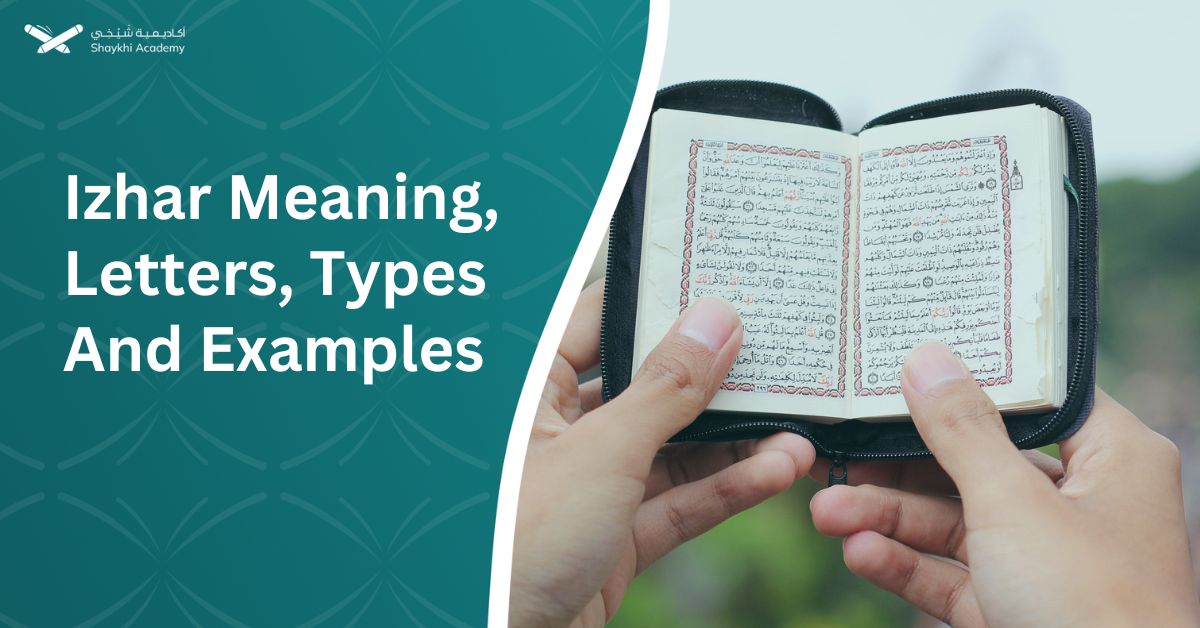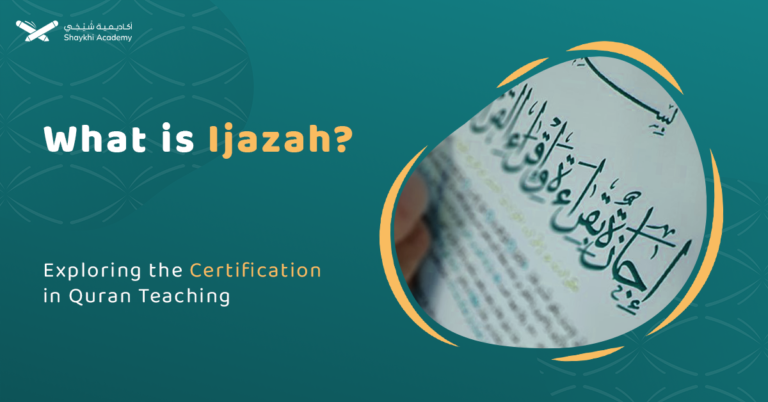Are you looking to deepen your understanding of Tajweed? Let’s delve into the intricate world of Izhar, an essential concept in the proper recitation of the Quran. But what exactly is Izhar? Derived from Arabic, Izhar means to make something apparent, clear, or visible.
In Tajweed, Izhar plays a pivotal role in ensuring the precise pronunciation of specific letters, particularly when they follow a Noon Sakinah or Tanween. But which letters are considered Izhar letters, and what are the rules governing their pronunciation?
Join us as we explore Izhar Halqi, Izhar Shafawi, and Izhar Mutlaq, each with its own set of rules and examples. By mastering the principles of Izhar, you can enhance your Quranic recitation skills and fulfill the requirement of reciting the Quran with clarity and accuracy. Ready to embark on this enriching journey? Let’s unravel the mysteries of Izhar together!
In a nutshell, Tajweed is a set of rules that ensures the proper pronunciation of the Quran, and Izhar is one of the fundamental rules in Tajweed. It refers to pronouncing certain letters clearly, without any interruption, silence, stress, or nasalization.
There are three types of Izhar: Izhar Halqi, Izhar Shafawi and Izhar Mutlaq. Izhar Halqi focuses on the clear pronunciation of the letters hamza, haa, ain, haa, ghin and khaa after a noon sakinah or tanween.
Izhar Shafawi emphasizes the clear pronunciation of the letter meem when it appears in its consonant state. Izhar Mutlaq focuses on clarifying the pronunciation of the consonant noon when it is followed by the letters waw and yaa. By following these rules, reciters can enhance their pronunciation skills and recite the Quran correctly.
What is Izhar?
In Arabic, “Izhar” (إظهار) means to make something apparent, clear, or visible. It is derived from the root word “ظهر” which means “to appear” or “to become evident”. It is a term used in various contexts, including grammar, linguistics, and Tajweed.
Izhar In Tajweed Tajweed
In Tajweed, Izhar is a fundamental rule governing the proper recitation of the Quran. It specifies the pronunciation of certain letters, known as Izhar letters, when they occur after a noon sakinah or tanween. The purpose of Izhar is to ensure clarity and precision in recitation, allowing each letter to be pronounced distinctly and accurately.
Izhar plays a crucial role in Tajweed as it helps maintain the integrity of the Quranic text and ensures that each word is recited correctly according to the rules of Arabic phonetics. By observing the principles of Izhar, reciters can enhance their pronunciation skills and fulfill the requirement of reciting the Quran with proper articulation and clarity.
What are the Izhar Letters?
The Izhar letters in Tajweed refer to a specific group of six Arabic letters that require clear pronunciation when following a Noon Sakinah (a still nun) or Tanween (nunation). These letters are:
- Hamz (ء): This is the glottal stop letter, represented by a small diagonal line above or below a letter.
- Haa (هـ): The letter “haa” is pronounced with a slight breathy sound and is one of the letters of the throat.
- Ain (ع): It is a letter pronounced from the depths of the throat.
- Haa (ح): Another letter from the throat, pronounced deeper than the regular “haa”.
- Ghin (غ): This is the sound of the voiced velar fricative, unique to Arabic.
- Khaa (خ): It is pronounced from the back of the throat, with a guttural sound.
When any of these six letters appear after a Noon Sakinah or Tanween, they must be pronounced distinctly and without any nasalization. This ensures clear separation between words and maintains the correct meaning of the Quranic text.
What are the Types of Izhar?
There are three types of Izhar, and each type of Izhar has its own set of rules:
- Izhar Halqi: This type of Izhar involves the clear pronunciation of the letters hamza (ء), haa (ه), ain (ع), haa (ح), ghin (غ), and khaa (خ) when they are preceded by a Noon Sakinah or Tanween.
- Izhar Shafawi: This type of Izhar specifically pertains to the letter meem (م) when it appears in its consonant state. In this case, all subsequent letters following the meem sakinah must be pronounced clearly.
- Izhar Mutlaq: This type of Izhar focuses specifically on clarifying the pronunciation of the consonant noon when it is followed by the letters waw and yaa.
It is important to learn these rules of Izhar in order to pronounce the Quran correctly. Let us discuss each type in detail, with its own rules and examples.
What is Izhar Halqi?
Izhar Halqi involves several letters:hamza (ء), haa (ه), ain (ع), haa (ح), ghin (غ), and khaa (خ). When any of these letters appear after the Sakinah Noon or Tanween, they must be enunciated clearly. The term “halqi” is derived from the Arabic word for throat, as these letters originate from the throat when pronounced. The clarity of pronunciation is crucial in distinguishing between words and conveying their meanings accurately.
Here are some examples of Izhar Halqi with the noon sakinah and tanween. Let’s practice pronouncing Izhar Halqi using these Quranic examples with transliteration:
1. Examples of Hamza ء With the Noon Sakinah and Tanween
- Example of Hamza with the noon sakinah in a word:
“وَهُمْ يَنْهَوْنَ عَنْهُ وَيَنْأَوْنَ عَنْهُ ۖ وَإِن يُهْلِكُونَ إِلَّا أَنفُسَهُمْ وَمَا يَشْعُرُونَ” “Wahum yanhawna AAanhu wayanawna AAanhu wain yuhlikoona illa anfusahum wama yashAAuroona” (Surat Al-An’am, 26)
- Example of Hamza with the noon sakinah in two words:
“وَمَا هُم بِضَارِّينَ بِهِ مِنْ أَحَدٍ إِلَّا بِإِذْنِ اللَّهِ”
“wama hum bidarreena bihi min ahadin illa biithni Allahi” (Surat Al-Baqarah, 102)
- Example of Hamza After Tanween:
“وَأَعْتَدْنَا لِلْكَافِرِينَ مِنْهُمْ عَذَابًا أَلِيمًا”
“waaAAtadna lilkafireena minhum AAathaban aleeman” (Surat An-Nisa’, 161
2. Examples of Haa هـ With the Noon Sakinah and Tanween
- Example of Haa with the noon sakinah in a word:
“جَنَّاتٍ تَجْرِي مِن تَحْتِهَا الْأَنْهَارُ ۖ كُلَّمَا رُزِقُوا مِنْهَا مِن ثَمَرَةٍ رِّزْقًا”
“jannatin tajree min tahtiha alanharu kullama ruziqoo minha min thamaratin rizqan qaloo hatha allathee ruziqna” (Surat Al-Baaqarah, 25)
- Example of Haa with a noon sakinah in two words:
“وَمَنْ يُضْلِلِ اللَّهُ فَمَا لَهُ مِنْ هَادٍ”
“waman yudlili Allahu fama lahu min hadin” (Surat Al-Ra’d, 33)
- Example of Haa after Tanween:
“سَلَامٌ هِيَ حَتَّىٰ مَطْلَعِ الْفَجْرِ”
“Salamun hiya hatta matlaAAi alfajri” (Surat Al-Qadr, 5)
3. Examples of Ain ع With the Noon Sakinah and Tanween
- Example of Ain with the noon sakinah in a word:
“صِرَاطَ الَّذِينَ أَنْعَمْتَ عَلَيْهِمْ غَيْرِ الْمَغْضُوبِ عَلَيْهِمْ وَلَا الضَّالِّينَ”
“Sirata allatheena anAAamta AAalayhim ghayri almaghdoobi AAalayhim wala alddalleena” (Surat Al-Fatiha, 7)
- Example of Ain with the noon sakinah in two words:
“وَلَوْ أَنَّهُمْ آمَنُوا وَاتَّقَوْا لَمَثُوبَةٌ مِّنْ عِندِ اللَّهِ خَيْرٌ ۖ لَّوْ كَانُوا يَعْلَمُونَ ”
“Walaw annahum amanoo waittaqaw lamathoobatun min AAindi Allahi khayrun law kanoo yaAAlamoona” (Surat Al-Baqarah, 103)
- Example of Ain After tanwen:
“مَّا يَفْعَلُ اللَّهُ بِعَذَابِكُمْ إِن شَكَرْتُمْ وَآمَنتُمْ ۚ وَكَانَ اللَّهُ شَاكِرًا عَلِيمًا”
“Ma yafAAalu Allahu biAAathabikum in shakartum waamantum wakana Allahu shakiran AAaleeman”
(Surat An-Nisa, 147)
4. Examples of Haa ح With the Noon Sakinah and Tanween
- Example of Haa with the noon sakinah in a word:
“فَصَلِّ لِرَبِّكَ وَانْحَرْ”
“Fasalli lirabbika wainhar” (Surat Al-Kauthar, 2)
- Example of Haa with the noon sakinah in two words:
“وَمِنْ حَيْثُ خَرَجْتَ فَوَلِّ وَجْهَكَ شَطْرَ الْمَسْجِدِ الْحَرَامِ”
“Wamin haythu kharajta fawalli wajhaka shatra almasjidi alharami”
(Surat Al-Baqarah, 149)
- Example of Haa After Tanween:
“إِنَّ اللَّهَ كَانَ عَلِيمًا حَكِيمًا”
“inna Allaha kana AAaleeman hakeeman” (Surat An-Nisa, 11)
5. Examples of Ghin غ With the Noon Sakinah and Tanween
- Example of Ghin with the noon sakinah in a word:
“فَسَيُنْغِضُونَ إِلَيْكَ رُؤُسَهُمْ”
“fasayunghidoona ilayka ruoosahum” (Surat Al-Israa, 51)
- Example of Ghin with the noon sakinah in two words
“وَنَزَعْنَا مَا فِي صُدُورِهِم مِّنْ غِلٍّ إِخْوَانًا عَلَىٰ سُرُرٍ مُّتَقَابِلِينَ”
“WanazaAAna ma fee sudoorihim min ghillin ikhwanan AAala sururin mutaqabileena” (Surat Al-Hijr, 47)
- Examples of Ghin After Tanween:
“وَنَجَّيْنَاهُم مِّنْ عَذَابٍ غَلِيظٍ”
“wanajjaynahum min AAathabin ghaleethin” (Surat Hud, 58)
6. Examples of Kha خ With the Noon Sakinah and Tanween
- Example of Kha with the noon sakinah in a word
“وَالْمُنْخَنِقَةُ وَالْمَوْقُوذَةُ”
“waalmunkhaniqatu waalmawqoothatu” (Surat Al-Ma’idah, 3)
- Example of Khaa with the noon sakinah in two words:
“الَّذِي أَطْعَمَهُم مِّن جُوعٍ وَآمَنَهُم مِّنْ خَوْفٍ”
“Allathee atAAamahum min jooAAin waamanahum min khawfin” (Surat Quraysh, 4)
- After Tanween:
“إِنَّ اللَّهَ كَانَ عَلِيمًا خَبِيرًا”
“inna Allaha kana AAaleeman khabeeran” (Surat An-Nisa, 35).
What is Izhar Shafawi?
Izhar Shafawi pertains specifically to the letter “meem” “م” when it appears in its consonant state. In this case, all subsequent letters following the meem sakinah must be pronounced clearly. However, there are exceptions to this rule. When the letters meem or baa follow the meem sakinah, they are not pronounced; instead, they are hidden or assimilated into the meem sakinah.
Let’s practice pronouncing Izhar Shafawi using these Quranic examples with transliteration:
- “الْحَمْدُ لِلَّهِ رَبِّ الْعَالَمِينَ”
“Alhamdu lillahi rabbi alAAalameena” (Surat Al-Fatiha, 2)
- “أَلَمْ يَجْعَلْ كَيْدَهُمْ فِي تَضْلِيلٍ”
“Alam yajAAal kaydahum fee tadleelin” (Surat Alfeel, 2)
- “لَكُمْ دِينُكُمْ وَلِيَ دِينِ”
“Lakum deenukum waliya deeni” (Surat Al-Kafroon, 6)
- “إِنَّمَا نُطْعِمُكُمْ لِوَجْهِ اللَّهِ لَا نُرِيدُ مِنكُمْ جَزَاءً وَلَا شُكُورًا”
“Innama nutAAimukum liwajhi Allahi la nureedu minkum jazaan wala shukooran” (Surat Al-Insan, 9)
What is Izhar Mutlak?
Izhar Mutlak focuses specifically on clarifying the pronunciation of the consonant “noon” when it is followed by the letters “waw” and “yaa”. It emphasizes the necessity of clearly articulating the noon without merging it with the subsequent letters. This ensures that the intended meaning of the word is conveyed accurately. Unlike Izhar Halqi, which relies on throat articulation, Izhar Mutlak does not depend on specific pronunciation mechanisms but rather emphasizes the clarity of pronunciation.
Examples of Izhar Mutlaq:
There are only four words in the Quran that always follow the rule of Izhar Mutlaq:
- بُنْيَانٌ (bunyanun) – meaning “building”
- قِنْوَانٌ (qawanun) – meaning “bunch of dates”
- صِنْوَانٌ (sinwanun) – meaning “pair”
- الدنيا (ad-dunya) – meaning “the world”
Here are some Ayat where these words are pronounced with Izhar Mutlaq in Quran:
- “إِنَّ اللَّهَ يُحِبُّ الَّذِينَ يُقَاتِلُونَ فِي سَبِيلِهِ صَفًّا كَأَنَّهُم بُنْيَانٌ مَّرْصُوصٌ”
“inna Allaha yuhibbu al-ladhina yuqatiluna fi sabeelihi saffan ka’annahum bunyanun marṣuṣun” (As-Saf, 4)
- “وَمِنَ النَّخْلِ مِن طَلْعِهَا قِنْوَانٌ دَانِيَةٌ وَجَنَّاتٍ مِّنْ أَعْنَابٍ وَالزَّيْتُونَ وَالرُّمَّانَ مُشْتَبِهًا وَغَيْرَ مُتَشَابِهٍ”
“wa mina an-nakhli min ṭal’iha qawanun daniyatun wa jannatin min a’nabin wa az-zaytun wa ar-rummana mushtabihan wa ghayra mutashabih” (Al-An’am, 99)
- “وَفِي الْأَرْضِ قِطَعٌ مُّتَجَاوِرَاتٌ وَجَنَّاتٌ مِّنْ أَعْنَابٍ وَزَرْعٌ وَنَخِيلٌ صِنْوَانٌ وَغَيْرُ صِنْوَانٍ يُسْقَى بِمَاءٍ وَاحِدٍ”
“wa fi al-arḍi qiṭa’un mutajawiratun wa jannatin min a’nabin wa zar’un wa nakhilun sinwanun wa ghayru sinwanin yusqā bi-mā’in wāḥidin” (Al-Ra’d, 4)
- “أُولَٰئِكَ الَّذِينَ اشْتَرَوُا الْحَيَاةَ الدُّنْيَا بِالْآخِرَةِ ۖ فَلَا يُخَفَّفُ عَنْهُمُ الْعَذَابُ وَلَا هُمْ يُنصَرُون”
“Olaika allatheena ishtarawoo alhayata alddunya bialakhirati fala yukhaffafu AAanhumu alAAathabu wala hum yunsaroon” (Surat Al-Baqarah, 86).
Mastering Izhar and Beyond: Unlock the Secrets of Beautiful Quran Recitation
Is mastering the intricacies of “Izhar” a hurdle in your Quran recitation journey? It doesn’t have to be! In this article, we delved deep into the concept of Izhar in Tajweed, exploring its definition, the letters involved, and how it impacts pronunciation.
But Izhar is just one piece of the Tajweed. To recite the Quran with confidence, fluency, and true beauty, a comprehensive understanding of Tajweed principles is essential.
Ready to take your Quran recitation to the next level?
Shaykhi Academy’s Online Tajweed Course
Join Shaykhi Academy’s Online Tajweed Course and gain a thorough understanding of all Tajweed rules, including Izhar and more.
In our online course, you’ll:
- Master Izhar with confidence: Learn the nuances of Izhar pronunciation, including the distinct sounds of the six Izhar letters and how they interact with Noon Sakinah and Tanween.
- Explore all Tajweed rules: Go beyond Izhar and delve into the complete spectrum of Tajweed principles, including proper Makharij (articulation points) and Sifat (characteristics) of Arabic letters, along with rules like Idgham, Ikhfa, and Madd.
- Receive expert guidance: Our certified native Arabic tutors, both male and female, will provide personalized instruction to address any specific challenges you might face with Izhar or other Tajweed rules.
- Experience practical application: Move from theory to practice by applying Tajweed rules in real-time, gaining the skills to identify and correct your own recitation for an overall improvement.
Let Shaykhi Academy be your guide on this enriching journey. Book your FREE trial today!
Shaykhi Academy goes beyond just teaching Tajweed. Discover Your Quranic Path:
- New to Arabic? Our “Arabic Noorani Qaida” course lays the groundwork for a lifetime of Quranic understanding.
- Looking for engaging lessons for your kids? “Online Quran Classes for Kids” fosters a love for learning that lasts.
- Ready to master recitation? “Tajweed Rules” equips you with the confidence to recite beautifully and accurately.
- Yearning to memorize the Quran? “Quran Hifz for Kids” or “Quran for Adults” provides a structured path, step-by-step.
- Delve deeper: Explore the richness of the Arabic language with “Online Arabic Courses” or broaden your Islamic knowledge with “Islamic Studies“.
Visit our website to learn more about Izhar and register for your free trial session!

Conclusion
In conclusion, Izhar, derived from the Arabic root “ظهر”, meaning clarity or visibility, holds significant importance in Tajweed, particularly in Quranic recitation. It ensures the proper pronunciation of certain letters, known as Izhar letters, when they follow a Noon Sakinah or Tanween.
The three types of Izhar—Halqi, Shafawi, and Mutlaq—each have their own set of rules governing pronunciation clarity, ensuring accurate recitation of the Quran. By adhering to these rules, reciters can maintain the integrity of the Quranic text, convey its meanings accurately, and enhance their pronunciation skills.
Through examples and practice, learners can grasp the nuances of Izhar and embody the essence of Tajweed in their recitation endeavors.

















































